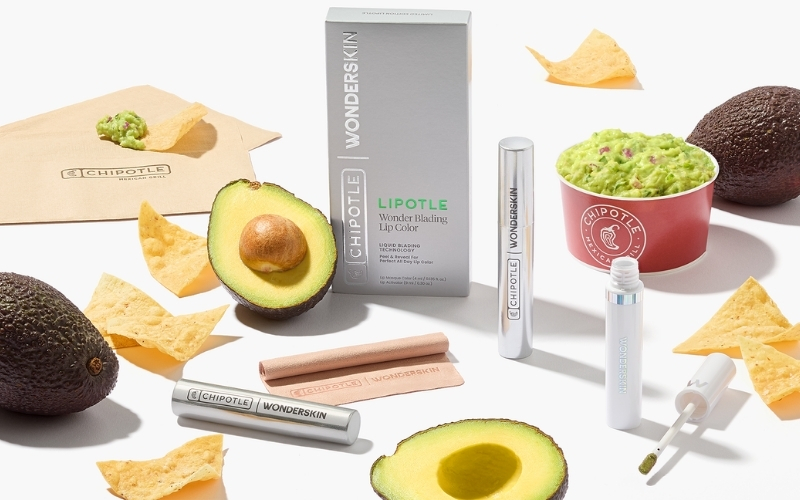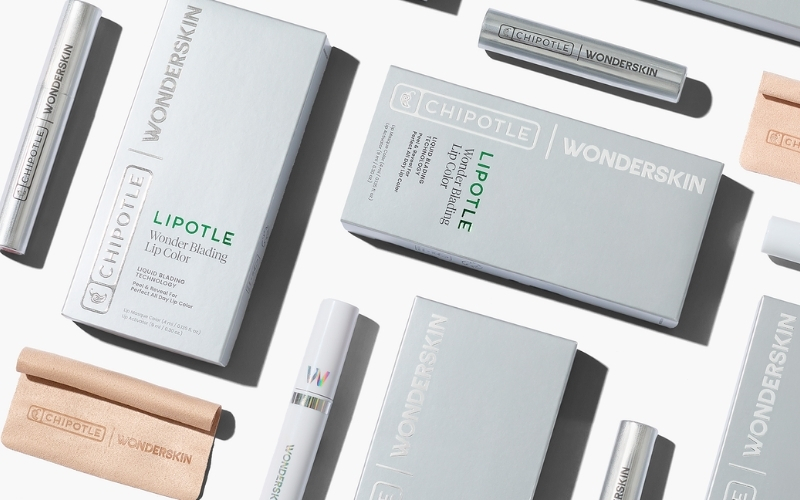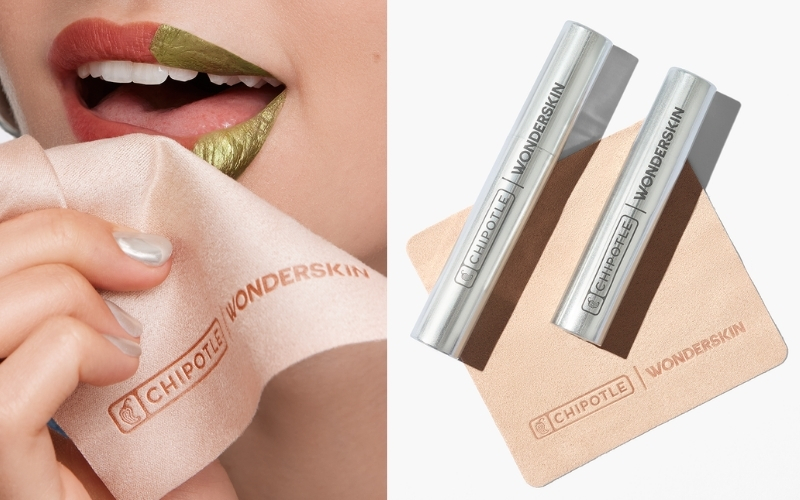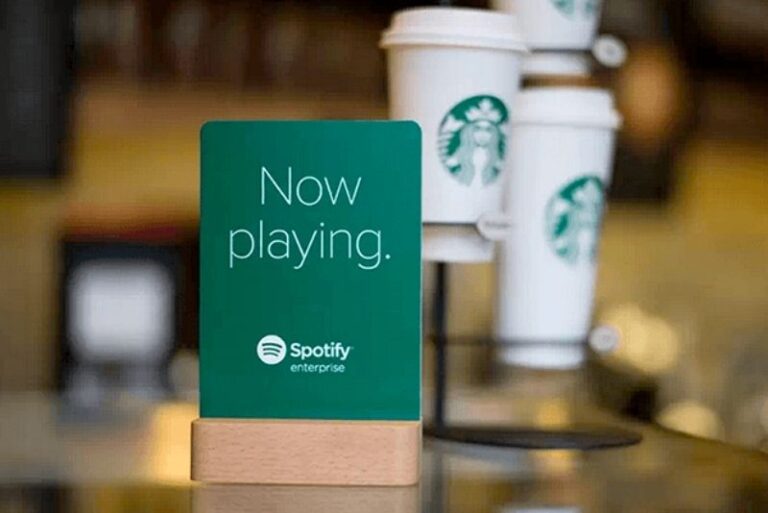Chipotle recently announced something new. It wasn’t a new protein to add to your burrito bowl, nor was it a new way of ordering said bowl. In fact, this is something that—as far we know, at least—you don’t even buy in their restaurants. It’s makeup.
That’s right, Chipotle is taking a fast-casual dip into the beauty space with its first-ever product: a lip stain. For those unfamiliar, lip stain is like lipstick, but much longer lasting and well-known for staying on even through meals and drinks. This co-branding effort with Wonderskin, a beauty brand recognized for its durable products, cleverly links Chipotle’s flavorful meals with a solution that promises to keep your lip stain intact. Are you starting to see the connection here?
Finally, there’s a lipstick that won’t schmear off as you’re downing your barely-fits-in-your-hands Chipotle burrito.
Have we finally peaked as a species?
Although that question is the topic for another day and undoubtedly for people much smarter than us lowly branders, this announcement did get us thinking: How do brands successfully expand beyond their original “purview”? Can combining two seemingly unrelated brands enable that expansion while resonating with audiences and still staying true to their original domain?
Proven Systems for Business Owners, Marketers, and Agencies
→ Our mini-course helps you audit and refine an existing brand in 15 days, just 15 minutes a day.
→ The Ultimate Brand Building System is your step-by-step blueprint to building and scaling powerful brands from scratch.
Table of Contents
Understanding Co-Branding
Essentially, and for the sake of this article, co-branding refers to when two (usually well-established) brands partner to create a product or experience that reflects some part of both their identities.
In this instance, Chipotle teamed up with Wonderskin, a beauty brand to produce a burrito-proof lip stain by combining Chipotle’s association with flavorful meals and Wonderskin’s reputation for long-lasting beauty products. Both brands stand to win: Chipotle generated a bit of shock value as it extended well beyond food, and Wonderskin walked the walk with a real-life use case showcasing that their product lasts through a potentially messy meal.
The Strategic Partnership Between Chipotle and Wonderskin

This unexpected co-branding between Chipotle and Wonderskin is an interesting example of how two brands unite to create something that is simultaneously functional and out of the ordinary. They fulfilled the dreams of those seeking a burrito-proof lip stain with their new product, ‘Lipotle.’ This limited-edition green Wonder Blading Peel and Reveal Lip Stain Kit was launched on July 30th, 2024.
For Chipotle, it offers them an opportunity to position themselves as creative and playful, engaging an audience beyond its traditional diners. The lip stain goes right to the Achilles heel of a typical Chipotle meal and embraces it – a lip stain that won’t budge during a (likely) messy, flavor-packed meal.
Similarly, Wonderskin also enjoys an equally strategic partnership. By fusing its product with the notion of enjoying a messy meal without worrying about smudging your lipstick, Wonderskin identified a practical and humorous use case that was likely to gain favor with its brand followers.
Long-lasting, smudge-proof wear meets vibrant, casual brand energy – this strategic combination of Wonderskin’s and Chipotle’s brands allows for an amplification of each other’s messages in a way that’s really memorable and fun.
What Reason Might a Company Have to Consider Co-branding?

The most obvious answer is likely revenue. Companies arguably exist to make a profit, and if they can leverage their strengths in a completely new market or way, they have the opportunity to increase their earnings exponentially.
In some cases, that makes perfect sense for a company. You might say they have “permission” for that particular type of collaboration or extension because it still leverages skills or capabilities for which they’re known.
Go too far beyond your area of expertise, however, and you could very well be subject to criticism or, at worst, a hit to brand loyalty.
An example of this was the collaboration between Neiman Marcus and Target who teamed up for a holiday collection. Target’s customers—accustomed to mass-market, affordable items—found the luxury designs too expensive, while Neiman Marcus’ audience didn’t see the value in shopping at a discount retailer for premium products. This case shows that knowing your audiences and aligning the respective value your brand brings is key to a successful collaboration.
Likewise, Burger King partnered with Xbox to create a game called Sneak King. While quirky, the game was poorly received due to its odd premise and failure to resonate with the gaming community.
In addition to revenue generation, companies might consider co-branding for several other reasons, such as access to new customer segments (co-branding allows companies to tap into each other’s customer bases), an enhanced brand image when partnering with a well-respected brand, shared resources (by sharing technology and expertise), an increased brand exposure and awareness, and new types of innovation by offering unique products that standout.
Lastly, a company might consider a cobranding partnership simply to make a splash. Cheetos, in collaboration with Forever 21, launched a clothing line that incorporated their vibrant colors. And, now, Chipotle with its lip stain.
A lot of these ideas have only upsides. If the new product succeeds, great! That’s additional revenue for the brand, perhaps even ongoing. Whereas, if it fails, it’s still developed buzz, gotten eyeballs on their brand, and maybe even gone viral on a platform or two, often heralding the brand for their creativity.
What Determines Whether a Co-brand Will Be Successful?
That might be the million-dollar question.
The intent of the partnership—whether it truly is an attempt to enter a new space vs. just a ploy to make some waves—will have a tremendous impact on what sort of permission brands might have from consumers. But here are some things we’ve found to be true across successful partnerships:
First, find the overlap. Effective co-branding works when two brands work together to solve a shared challenge that resonates with their audiences. Going back to Lipotle, Chipotle’s co-branding with Wonderskin, Chipotle’s inevitable messy meal pairs perfectly with Wonderkin’s commitment to long-lasting products.
Next, leverage your strengths. Each brand should bring something unique to the table. Chipotle brought its quirky, food-centric humor, while Wonderskin brought a functional solution that solves a problem for beauty consumers.
Then, create a splash moment. One of the key reasons co-branding works is its ability to create a buzz. Guac-proof lip stain is so completely unexpected that it was bound to make the rounds on TikTok – even potentially go viral.
But always, always remember that authenticity is key, and that’s true for both brands. Each needs to stay true to their respective value proposition, ensuring that the partnership resonates with consumers and doesn’t feel (too) gimmicky.
Because, for every Burger King / Xbox or Target / Neiman Marcus co-branding flop, there is an unexpected success. Starbucks and Spotify joined forces to create enhanced in-store experiences for customers by allowing them to engage with music curated by Spotify. Doritos and Taco Bell collaborated to create Doritos Locos Tacos which was a resounding success.
When our clients ask us about collaborations, we usually rely on research and analogies (e.g. Have other companies made similar moves?) to help guide them to an informed decision.
But, at least the good news is, if things go wrong, you can always say you “did it for the ‘gram”.
To learn more about this type of branded partnerships and discover additional real-life examples, read our article about the concept of co-branding here.
References
- Chipotle.com. (2024). Chipotle and Wonderskin Launch ‘Lipotle’ Lip Stain in Celebration of National Avocado Day – Jul 29, 2024. [online] Available at: https://newsroom.chipotle.com/2024-07-29-CHIPOTLE-AND-WONDERSKIN-LAUNCH-LIPOTLE-LIP-STAIN-IN-CELEBRATION-OF-NATIONAL-AVOCADO-DAY#assets_all [Accessed 18 Sep. 2024].









